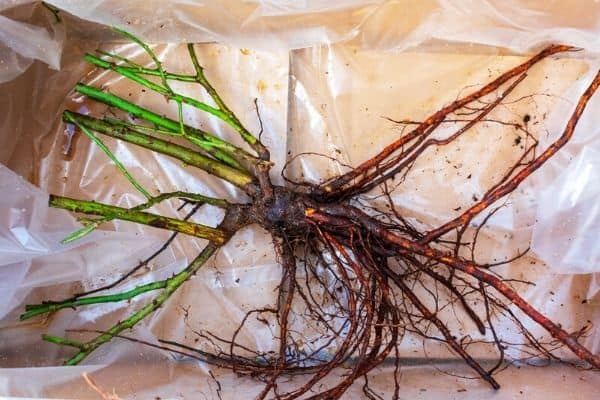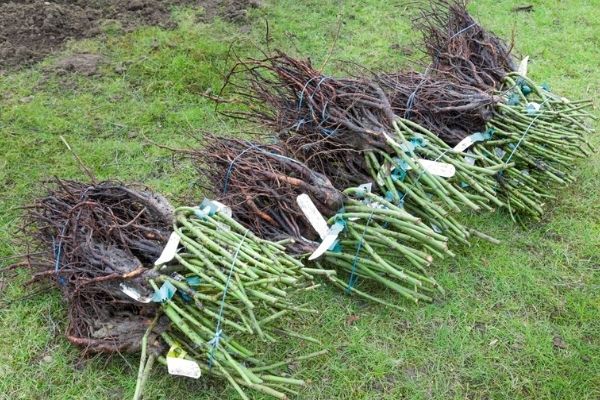Healthy rose roots are essential for transporting water and nutrients to the plant so it can produce beautiful flowers.
In this complete guide to rose roots I’ll explain the structure of rose roots and share my tips for uprooting and planting bare root roses, and give you my tips for keeping your rose roots healthy.
This post contains affiliate links. Please read the disclosure for more info.

Rose root structure
Roses have two types of roots – thick roots that help to stabilize the plant, keep it upright and store nutrients and thin feeder roots that absorb nutrients from the soil.
The feeder roots are covered in hair like growths to help with absorption.
As the plants grow, the roots become thick and woody to support the plant.
How to promote healthy rose root growth
Roses need loose, easily draining soil to develop strong roots.
They’re heavy feeders so it’s a good idea to dig some aged compost into the soil before planting your roses.
You can also help protect the roots by adding a thick layer of compost around each plant.
This helps to insulate the roots from heat and cold and reduces weeds.
Grafting roses
Grafting is a process that combines the roots of a rose with the stem of another type of rose.
Some varieties of roses have beautiful flowers but weak roots, so by grafting roses you can get the benefits of a strong rootstock as well as gorgeous flowers.
The two sections are fixed together with tape and the grafted buds will grow and form a new rose plant.
Which animals eat rose roots?
Gophers and voles, also known as meadow mice or field mice, will eat rose roots.
Moles are burrowing animals that don’t eat the roots, but their digging and tunnelling can damage the root system of rose plants.

Pests and diseases
The roots of rose plants can also be damaged by nematodes, causing the plants to wilt, grow slowly and the leaves may turn yellow.
Nematodes can find their way into the garden from infested plants or soil.
Phytophthora and Pythium are pathogens that affect rose roots and cause roses to wilt.
Roses can be infected with these pathogens from contaminated water or potting mix. [1]
How deep do rose roots grow?
Rose bush roots can grow down to about 3 feet (90 cm) deep and spread out 3 feet wide so it’s best to give your roses plenty of space when planting, especially large varieties like climbing roses.
Are rose roots invasive?
Rose roots are not invasive so they won’t damage pipes, concrete or the foundations of your house.
If you have a leaking pipe, the roots will grow towards the pipe to access the water but they’re not strong enough to break through a pipe.
How to remove rose roots
Rose bushes that have been removed from the garden can regrow from the roots left behind.
If you have an unwanted rose growing in the garden you’ll need to remove as much of the root system as possible to stop it regrowing.
Dig down as far and wide as you can to remove all of the visible roots.
You may also need to use a glyphosate herbicide to get rid of the remaining roots.

Uprooting rose bushes
The best time to uproot and transplant a rose bush is in early spring when the plant is still in a dormant state.
If you live in an area with late season frosts you’ll need to wait until the risk of frost has passed.
Dig the new hole first so that you can transplant the rose as soon as you dig it up.
Dig at least 12 to 18 inches (30 to 45 cm) away from the root ball so that roots are not damaged.
Gently transfer the rose bush to the new hole and replant it.
Planting bare root roses
Rose plants are often sold in bare root form, which means all of the soil has been removed from around the roots.
This makes it easier to transport the plants.
If you’re buying bare root roses from your local garden center check that the roots are well formed and not dried out or slimy.
Bare root roses can be planted in late winter in warm climates or mid spring in cool climates.
Soak the roots in a bucket of water for about two hours before planting and remove any roots that are damaged.
Dig a hole about 12 to 18 inches (30 to 45 cm) deep and 2 feet (60 cm) wide.
Place the plant in the hole and spread the roots out around the plant.
Backfill the hole with a mix of compost and soil and water thoroughly.

Root bound container roses
Roses planted in containers can become root bound after a few years in the same pot.
If you notice water sitting on the surface of the soil that is taking a long time to soak in or roots growing out the bottom of the pot, it’s time to repot your rose into a larger container.
You can also remove the rose from the pot, trim back the root system and plant it back in the same pot with some fresh potting soil.
RELATED ARTICLES
- How To Save A Wilted Rose Bush
- 15 Red Flowering Shrubs
- 5 Winter Flowering Annuals
- 10 Rose Alternative Flowers
So there is my guide to rose bush roots.
With the right care your roses will reward you with beautiful blooms year after year.
How do you care for the roots of your rose plants? Let me know in the comments below.
Are you on Pinterest? I have boards dedicated to Flower Gardens and Garden Ideas that you may enjoy. You can also find me on Facebook.






Hi, I have a couple of standard roses that have been growing in containers for years. They are now leaning over a lot and I suspect it is because of lopsided root growth that is causing pressure on one side of the container. What I’d like to do is take them out of the containers and, if the leaning is caused by lopsided root growth, trim the roots and replant them in the new soil in the same containers. But I am not sure how to trim rose roots without damaging them. Could you give me some advice on the dos and don’ts please.
Hi Tam, you can trim the rose roots by up to one half without causing any damage to the plant. It’s best to do it when the rose is dormant and do it in the shade so the roots don’t dry out while you’re working.